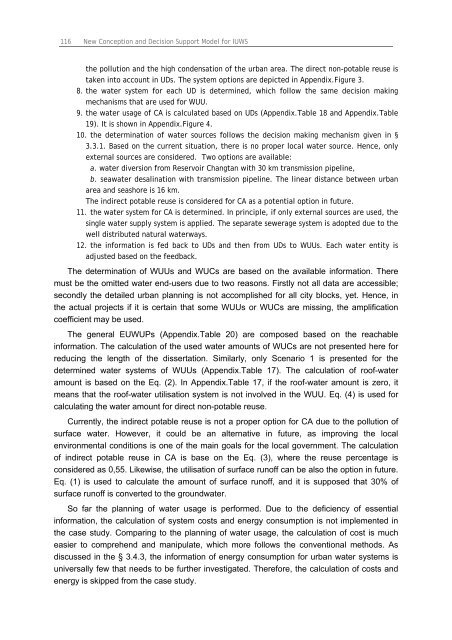Chapter 3 Decision Support Model (IUWS-DSM) - Tubdok
Chapter 3 Decision Support Model (IUWS-DSM) - Tubdok
Chapter 3 Decision Support Model (IUWS-DSM) - Tubdok
Create successful ePaper yourself
Turn your PDF publications into a flip-book with our unique Google optimized e-Paper software.
116 New Conception and <strong>Decision</strong> <strong>Support</strong> <strong>Model</strong> for <strong>IUWS</strong><br />
the pollution and the high condensation of the urban area. The direct non-potable reuse is<br />
taken into account in UDs. The system options are depicted in Appendix.Figure 3.<br />
8. the water system for each UD is determined, which follow the same decision making<br />
mechanisms that are used for WUU.<br />
9. the water usage of CA is calculated based on UDs (Appendix.Table 18 and Appendix.Table<br />
19). It is shown in Appendix.Figure 4.<br />
10. the determination of water sources follows the decision making mechanism given in §<br />
3.3.1. Based on the current situation, there is no proper local water source. Hence, only<br />
external sources are considered. Two options are available:<br />
a. water diversion from Reservoir Changtan with 30 km transmission pipeline,<br />
b. seawater desalination with transmission pipeline. The linear distance between urban<br />
area and seashore is 16 km.<br />
The indirect potable reuse is considered for CA as a potential option in future.<br />
11. the water system for CA is determined. In principle, if only external sources are used, the<br />
single water supply system is applied. The separate sewerage system is adopted due to the<br />
well distributed natural waterways.<br />
12. the information is fed back to UDs and then from UDs to WUUs. Each water entity is<br />
adjusted based on the feedback.<br />
The determination of WUUs and WUCs are based on the available information. There<br />
must be the omitted water end-users due to two reasons. Firstly not all data are accessible;<br />
secondly the detailed urban planning is not accomplished for all city blocks, yet. Hence, in<br />
the actual projects if it is certain that some WUUs or WUCs are missing, the amplification<br />
coefficient may be used.<br />
The general EUWUPs (Appendix.Table 20) are composed based on the reachable<br />
information. The calculation of the used water amounts of WUCs are not presented here for<br />
reducing the length of the dissertation. Similarly, only Scenario 1 is presented for the<br />
determined water systems of WUUs (Appendix.Table 17). The calculation of roof-water<br />
amount is based on the Eq. (2). In Appendix.Table 17, if the roof-water amount is zero, it<br />
means that the roof-water utilisation system is not involved in the WUU. Eq. (4) is used for<br />
calculating the water amount for direct non-potable reuse.<br />
Currently, the indirect potable reuse is not a proper option for CA due to the pollution of<br />
surface water. However, it could be an alternative in future, as improving the local<br />
environmental conditions is one of the main goals for the local government. The calculation<br />
of indirect potable reuse in CA is base on the Eq. (3), where the reuse percentage is<br />
considered as 0,55. Likewise, the utilisation of surface runoff can be also the option in future.<br />
Eq. (1) is used to calculate the amount of surface runoff, and it is supposed that 30% of<br />
surface runoff is converted to the groundwater.<br />
So far the planning of water usage is performed. Due to the deficiency of essential<br />
information, the calculation of system costs and energy consumption is not implemented in<br />
the case study. Comparing to the planning of water usage, the calculation of cost is much<br />
easier to comprehend and manipulate, which more follows the conventional methods. As<br />
discussed in the § 3.4.3, the information of energy consumption for urban water systems is<br />
universally few that needs to be further investigated. Therefore, the calculation of costs and<br />
energy is skipped from the case study.

















